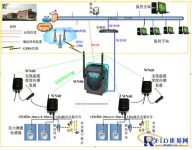
400M digital communication system for forest fire prevention in Beijing
[ad_1]
1. Case description:
General introduction
Beijing 400-megabit forest fire prevention digital communication system is a digital communication platform, which organically combines the advantages of two-way wireless communication and digital technology, and has made a qualitative leap in frequency usage, call quality, and comprehensive business functions. The system adopts advanced DMR (Digital Mobile Radio) and TDMA (Time Division Multiple Access) technology, the number of users supported on a single 12.5kHz channel is doubled compared to the analog system, saving equipment investment. Improve spectrum utilization, enhance integrated data communication and voice communication, use the same pair of frequencies to effectively expand signal coverage, save frequency resources, effectively solve the problems of co-frequency interference and wireless interconnection, and have strong anti-interference ability , clear voice, long communication distance, flexible grouping and networking, etc., can realize channel sharing and flexible configuration and use, and powerful scheduling function, which can greatly change the current communication status. The system adopts a comprehensive combination of signaling features to manage the intercom group, so that each user has a unique ID for easy identification. The 400-megabyte forest fire prevention digital communication system can promote the improvement of the management and use level with its inherent security, confidentiality and scalability, and solve the requirements that cannot be achieved by analog routines. This system fully meets our current and future application requirements, and is the first choice for forestry digital communication systems.

2. Function description
1. Digital voice function
group call
With digital group calling, members of the talk group can share a channel without disturbing other walkie-talkie users.
Both the transmitter and receiver radios must be on the same logical channel (frequency and time slot).
private call
Private calling allows a radio user to communicate directly with another radio user, regardless of whether they belong to the same talkgroup list. Typically, walkie-talkie users who need to communicate with each other can form a talkgroup and be configured as members of the talkgroup.
Through private calls, one-to-one communication can be performed between the transceivers at the transmitter and receiver. Instead of initiating a group call to let the entire group know about a security incident, employees can privately alert specific managers of a security incident through a private call.
call all
With Call All, a privileged radio can have a one-way conversation with other radio users on the same logical channel.
The transmitter radio utilizes a special all-call talkgroup so that all other radio users on the same logical channel (regardless of which talkgroup they belong to) can receive the communication.
This feature is particularly useful for supervisors to communicate with all radios on the same logical channel (frequency and time slot), rather than individual talkgroups or users.
digital signaling
The digital signaling function can send special packets over the network. Digital signaling functions include, kill walkie-talkies, remote monitoring, check walkie-talkies, call prompts and digital emergency calls.
Embedded Digital Signaling – PTT ID and Aliases
Aliases – When programming through the Client Software (CPS) or front panel, the screen will display a simple and clear “name”.
PTT ID – Allows the target radio to identify the call originator.
Remote kill walkie-talkie
Usually, a supervisor walkie-talkie can use this feature to remotely kill another walkie-talkie through wireless signaling.
Remote monitoring
Typically, a far-end user can take advantage of this feature to activate the target radio’s microphone and transmitter for a period of time.
Check the walkie-talkie
With this feature, the initiator radio can check whether the target radio in the system is active without its user knowing.
call alert
With this feature, the originator radio can basically ensure that the call goes to another radio user.
digital emergency call
The radio allows radio users in critical situations to send confirmed emergency alarm messages and emergency calls to the supervisor radio in the system.
2. Integrated data services
text messaging service
The radio can send and receive messages in text format, and users can create text messages in two ways:
1) Status or fixed messages (shortcut text), up to 30 messages can be programmed via client software (CPS).
2) A restricted free-form text message of up to 140 characters. Built-in text messages.
Support intercoms to send status messages to each other.
The walkie-talkie is supported to send messages to the talkgroup via text messages.
The handheld or car radio can store up to 30 messages at the same time.
Text messages are only supported in digital run mode.
GPS location service app
Both the handheld and vehicle-mounted radios have built-in GPS modules. With the help of the terminal location service application, the dispatcher can find out the current location of a walkie-talkie on the map displayed on the screen.
Using integrated data services, handheld and vehicle-mounted radios equipped with GPS modules can send their location coordinate information to the receiver application through a wireless communication system, which can display the radio’s geographic location on a high-resolution map.
[ad_2]



